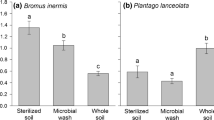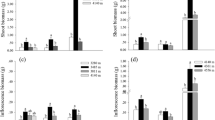Abstract
Wisconsin (USA) oak savannas are endangered plant communities that have remarkably high plant species diversity. To investigate factors underlying this richness, we experimentally investigated the potentially interacting effects of light gradients and arbuscular mycorrhizal fungi (AMF) on plant competition in the greenhouse, using a fully randomized block design. We used four plant species, soil, and AMF from a remnant sand savanna, under two light and five AMF treatments. Plants were grown four per pot under two competition treatments (either one or four species per pot) for 20 weeks. Using ANOVA, we found that all species showed significant treatment effects on total and shoot biomass, primarily due to differences in competition and light, less to AMF. However, effects were the opposite of predictions. Putatively mycorrhizal plants showed neutral to negative responses to AMF, and a nonmycorrhizal species outcompeted AMF species in infected pots. We concluded that our experimental setup of small pots, sandy soil, and long growing period had induced parasitism by the AMF on susceptible hosts. This unexpected result is consistent with field data from the sand savanna, and may help explain how nonmycorrhizal plants can compete successfully with AMF species in established, species-rich communities.



Similar content being viewed by others
References
Anderson RC, Hetrick BAD, Wilson GWT (1994) Mycorrhizal dependence of Andropogon gerardii and Schizachyrium scoparium in two prairie soils. Am Midl Nat 132:366–376
Eissenstat DM, Newman EI (1990) Seedling establishment near large plants—effects of vesicular–arbuscular mycorrhizas on the intensity of plant competition. Funct Ecol 4:95–99
Facelli E, Facelli JM, Smith SE, McLaughlin MJ (1999) Interactive effects of arbuscular mycorrhizal symbiosis, intraspecific competition and resource availability on Trifolium subterraneum cv. Mt. Baker. New Phytol 141:535–547
Fitter AH (1977) Influence of mycorrhizal infection on competition for phosphorous and potassium by two grasses. New Phytol 79:119–125
Fransson A-M, Aarle IM, Olsson PA, Tyler G (2003) Plantago lanceolata L. and Rumex acetosella L. differ in their utilisation of soil phosphorus fractions. Plant Soil 248:285–295
Goodwin J (1992) The role of mycorrhizal fungi in competitive interactions among native bunchgrasses and alien weeds—a review and synthesis. Northwest Sci 66:251–260
Grime JP, Mackey JML, Hillier SH, Read DJ (1987) Floristic diversity in a model system using experimental microcosms. Nature 328:420–422
Hamel C, Furlan V, Smith DL (1992) Mycorrhizal effects on interspecific plant competition and nitrogen transfer in legume grass mixtures. Crop Sci 32:991–996
Hartnett DC, Hetrick BAD, Wilson GWT, Gibson DJ (1993) Mycorrhizal influence on intraspecific and interspecific neighbor interactions among cooccurring prairie grasses. J Ecol 81:787–795
Hetrick BAD, Hartnett DC, Wilson GWT, Gibson DJ (1994) Effects of mycorrhizae, phosphorus availability, and plant density on yield relationships among competing tallgrass prairie grasses. Can J Bot 72:168–176
Klimes L, Klimesova J (1999) Root sprouting in Rumex acetosella under different nutrient levels. Plant Ecol 141:33–39
Klironomos JN (2003) Variation in plant response to native and exotic arbuscular mycorrhizal fungi. Ecology 84:2292–2301
Kytoviita MM, Vestberg M, Tuom J (2003) A test of mutual aid in common mycorrhizal networks: established vegetation negates benefit in seedlings. Ecology 84:898–906
Landis FC, Gargas A, Givnish TJ (2004) Relationships among arbuscular mycorrhizal fungi, vascular plants, and environmental conditions in oak savannas. New Phytol 164:493–504
Landis FC, Gargas A, Givnish TJ (2005) The influence of arbuscular mycorrhizae and light on Wisconsin (USA) sand savanna understories 1. Plant community composition. Mycorrhiza DOI 10.1007/s00572-005-0365-2
Leach MK, Givnish TJ (1999) Gradients in the composition, structure and diversity of remnant oak savannas in southern Wisconsin. Ecol Monogr 69:353–374
Marler MJ, Zabinski CA, Callaway RM (1999) Mycorrhizae indirectly enhance competitive effects of an invasive forb on a native bunchgrass. Ecology 80:1180–1186
Meisel J, Trushenski N, Weiher E (2002) A gradient analysis of oak savanna community composition in western Wisconsin. J Torrey Bot Soc 129:115–124
Moora M, Zobel M (1996) Effect of arbuscular mycorrhiza on inter- and intraspecific competition of two grassland species. Oecologia 108:79–84
Smith SE, Read DJ (1997) Mycorrhizal symbiosis. Academic, London
van der Heijden EW, Kuyper TW (2001) Laboratory experiments imply the conditionality of mycorrhizal benefits for Salix repens: role of pH and nitrogen to phosphorus ratios. Plant Soil 228:275–290
van der Heijden MGA, Boller T, Wiemken A, Sanders IR (1998a) Different arbuscular mycorrhizal fungal species are potential determinants of plant community structure. Ecology 79:2082–2091
van der Heijden MGA, Klironomos JN, Ursic M, Moutoglis P, Streitwolf-Engel R, Boiler T, Wiemken A, Sanders IR (1998b) Mycorrhizal fungal diversity determines plant biodiversity, ecosystem variability and productivity. Nature 396:69–72
van der Heijden MGA, Wiemken A, Sanders IR (2003) Different arbuscular mycorrhizal fungi alter coexistence and resource distribution between co-occurring plant. New Phytol 157:569–578
Acknowledgements
This work was funded in part by a grant from the National Science Foundation (DEB-0104928), by the estates of Elspeth Burgwin and Dr. DeWitt Landis, and by the Davis, Raper, and Allen funds. The authors wish to thank the US Department of Defense for providing access to Upper Tarr Creek. Many people contributed valuable time and expertise including Lyn Hummel, Steve Bentivenga, Kim Mello, and Mark Leach. Carrie J. Andrew, Luisa Arnedo, and Anne Barko deserve thanks for their work on this experiment. Finally, the authors wish to thank Paul Zedler, Robert Goodman, James Bockheim, Elisabeth Landis, and Terra Theim and two anonymous reviewers for their excellent comments on drafts of this work.
Author information
Authors and Affiliations
Corresponding author
Rights and permissions
About this article
Cite this article
Landis, F.C., Gargas, A. & Givnish, T.J. The influence of arbuscular mycorrhizae and light on Wisconsin (USA) sand savanna understories 2. Plant competition. Mycorrhiza 15, 555–562 (2005). https://doi.org/10.1007/s00572-005-0366-1
Received:
Accepted:
Published:
Issue Date:
DOI: https://doi.org/10.1007/s00572-005-0366-1




